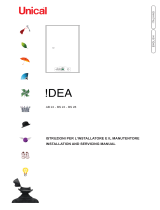
1
ENGLISH
GB
1. TABLE OF CONTENTS
1. TABLE OF CONTENTS ..................................................................................................................... 1
2. INDEX ................................................................................................................................................. 2
3. SAFETY .............................................................................................................................................. 3
4. GENERAL INFORMATION AND WARNINGS ................................................................................... 4
4.1. General guidelines ................................................................................................................... 4
4.2. Description of the appliance ..................................................................................................... 4
4.3. Protection appliances ............................................................................................................... 5
4.4. Rating plate .............................................................................................................................. 6
4.5. Replacement of components (service technician) ................................................................... 6
5. USE AND OPERATION ..................................................................................................................... 7
5.1. Description of the controls . ...................................................................................................... 7
5.2. Burner ignition .......................................................................................................................... 7
5.3. Filling the tank .......................................................................................................................... 8
5.4. Draining the container .............................................................................................................. 8
5.5. Guidelines on how to use ......................................................................................................... 8
6. CLEANING AND MAINTENANCE ..................................................................................................... 8
6.1. Guidelines on cleaning and maintenance ................................................................................ 8
6.2. Proper maintenance ................................................................................................................. 9
7. TROUBLESHOOTING ..................................................................................................................... 10
8. INSTALLATION ................................................................................................................................ 10
8.1. Packaging and unpacking ...................................................................................................... 10
8.2. Installation (service technician) .............................................................................................. 11
8.3. Water connection (service technician) ................................................................................... 11
8.4. Gas connection (service technician) ...................................................................................... 12
8.5. Extraction of fumes (service technician) ................................................................................ 12
8.6. Installation of the appliance in a line ...................................................................................... 13
8.7. Gas supply (service technician) ............................................................................................. 13
8.8. Inspection (service technician) ............................................................................................... 13
9. SETTINGS ........................................................................................................................................ 14
9.1. Minimum setting of burner valve (service technician) ............................................................ 14
9.2. Replacement of burner nozzle (service technician) ............................................................... 14
9.3. Replacement of igniting flame burner nozzle (service technician) ......................................... 15
10. APPLIANCE DISPOSAL .................................................................................................................. 15
ATTACHMENTS ....................................................................................................................................... I




















